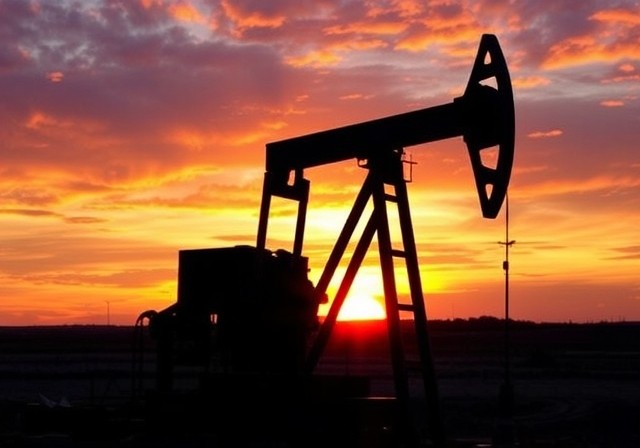
FROM OUR BLOG
FROM OUR BLOG
FROM OUR BLOG
How Crude Oil Prices Impact Economies and Investments
Dec 7, 2024



How Crude Oil Prices Impact Economies and Investments
Crude oil, often referred to as "black gold," is a cornerstone of the global economy. Its price fluctuations can have far-reaching effects on national economies, industries, and individual investments. Understanding these impacts is crucial for anyone navigating the financial markets or seeking to comprehend global economic trends.
1. Crude Oil as an Economic Driver
Energy and Industry
Crude oil is a primary energy source, fueling industries, transportation, and electricity production. Its price directly affects the cost of goods, services, and manufacturing globally.
Impact on Inflation
Rising oil prices often lead to increased transportation and production costs, contributing to inflation. Conversely, falling prices can alleviate inflationary pressures, boosting consumer purchasing power.
Geopolitical Influence
Countries that are major oil producers, such as Saudi Arabia and Russia, depend heavily on oil revenues. Price fluctuations can influence their economic stability, political policies, and currency values.
2. The Effects on Economies
Oil-Importing Countries
Negative Impact: Higher crude oil prices increase import bills, worsening trade balances and reducing economic growth.
Positive Impact: Declining oil prices can lower production costs, reduce inflation, and boost consumer spending.
Oil-Exporting Countries
Negative Impact: A drop in oil prices can lead to budget deficits and economic slowdowns for countries heavily reliant on oil exports.
Positive Impact: Rising oil prices provide a financial windfall, enabling greater government spending and investment.
3. Crude Oil and Investments
Energy Sector Stocks
The profitability of oil companies, such as ExxonMobil or Chevron, is directly tied to crude oil prices. Higher prices often lead to higher revenues and stock valuations for these firms.
Stock Market Volatility
Oil price shocks can trigger broader market volatility, especially in sectors like transportation, manufacturing, and airlines, which are sensitive to energy costs.
Impact on Bonds and Currencies
Bonds: Rising oil prices may prompt central banks to raise interest rates to combat inflation, affecting bond yields and prices.
Currencies: Oil prices influence the value of currencies, particularly in oil-dependent economies. For instance, the Canadian dollar often moves in tandem with oil price trends.
4. How Investors Can Navigate Oil Price Fluctuations
Diversify Portfolio
Diversification across asset classes and sectors can help mitigate risks associated with volatile oil prices.
Invest in Oil-Linked Assets
Consider oil-related ETFs, energy sector stocks, or futures contracts for direct exposure to oil price movements.
Monitor Macroeconomic Indicators
Stay informed about geopolitical events, OPEC decisions, and demand-supply dynamics to anticipate potential price changes.
Conclusion
Crude oil prices wield significant influence over economies and investment landscapes. By understanding the multifaceted effects of oil price movements, investors and policymakers can make informed decisions, whether to hedge risks or seize opportunities in this vital market.
Agricultural Commodities: Risks and Rewards
Agricultural commodities, ranging from wheat and corn to coffee and sugar, are essential components of the global economy. Trading and investing in these commodities offer unique opportunities and challenges, influenced by supply-demand dynamics, weather patterns, and geopolitical events.
1. What Are Agricultural Commodities?
Agricultural commodities are raw materials derived from farming and livestock production. They are categorized into:
Grains: Wheat, corn, soybeans, rice.
Soft Commodities: Coffee, cocoa, sugar, cotton.
Livestock: Cattle, hogs, poultry.
2. Rewards of Investing in Agricultural Commodities
Portfolio Diversification
Agricultural commodities often have low correlation with traditional asset classes like stocks and bonds, making them an excellent diversification tool.
Inflation Hedge
As the cost of living rises, so do the prices of food and raw materials, making agricultural commodities a valuable hedge against inflation.
Growing Global Demand
Population growth and rising incomes in developing economies drive increased demand for agricultural products, boosting their long-term investment potential.
3. Risks of Investing in Agricultural Commodities
Weather and Climate Risks
Weather conditions, such as droughts or floods, significantly impact crop yields, creating price volatility.
Geopolitical Uncertainty
Trade policies, tariffs, and geopolitical tensions can disrupt global agricultural markets.
Storage and Perishability
Physical agricultural commodities can deteriorate, adding logistical challenges for traders dealing with tangible goods.
Market Volatility
Prices of agricultural commodities are influenced by unpredictable factors, including pests, disease outbreaks, and technological advancements in farming.
4. How to Trade Agricultural Commodities
Futures Contracts
Most agricultural commodity trading occurs in futures markets, where contracts specify delivery of a product at a future date and price.
ETFs and Mutual Funds
Investors can gain exposure through funds that track agricultural commodities or related industries, such as farming equipment or fertilizer production.
Stocks
Investing in agribusiness companies provides indirect exposure to agricultural markets.
5. Strategies for Success
Understand the Market
Familiarize yourself with the supply-demand fundamentals and seasonal patterns of specific commodities.
Diversify Across Commodities
Reduce risk by investing in a range of agricultural commodities rather than focusing on a single product.
Monitor Global Trends
Stay informed about technological advancements, trade agreements, and changing consumer preferences that impact the agricultural sector.
Conclusion
Agricultural commodities present both significant rewards and inherent risks. For investors willing to navigate their complexities, they offer a way to diversify portfolios, hedge against inflation, and capitalize on global trends. A disciplined approach and thorough understanding of the market are essential to succeed in this dynamic investment arena.
How Crude Oil Prices Impact Economies and Investments
Crude oil, often referred to as "black gold," is a cornerstone of the global economy. Its price fluctuations can have far-reaching effects on national economies, industries, and individual investments. Understanding these impacts is crucial for anyone navigating the financial markets or seeking to comprehend global economic trends.
1. Crude Oil as an Economic Driver
Energy and Industry
Crude oil is a primary energy source, fueling industries, transportation, and electricity production. Its price directly affects the cost of goods, services, and manufacturing globally.
Impact on Inflation
Rising oil prices often lead to increased transportation and production costs, contributing to inflation. Conversely, falling prices can alleviate inflationary pressures, boosting consumer purchasing power.
Geopolitical Influence
Countries that are major oil producers, such as Saudi Arabia and Russia, depend heavily on oil revenues. Price fluctuations can influence their economic stability, political policies, and currency values.
2. The Effects on Economies
Oil-Importing Countries
Negative Impact: Higher crude oil prices increase import bills, worsening trade balances and reducing economic growth.
Positive Impact: Declining oil prices can lower production costs, reduce inflation, and boost consumer spending.
Oil-Exporting Countries
Negative Impact: A drop in oil prices can lead to budget deficits and economic slowdowns for countries heavily reliant on oil exports.
Positive Impact: Rising oil prices provide a financial windfall, enabling greater government spending and investment.
3. Crude Oil and Investments
Energy Sector Stocks
The profitability of oil companies, such as ExxonMobil or Chevron, is directly tied to crude oil prices. Higher prices often lead to higher revenues and stock valuations for these firms.
Stock Market Volatility
Oil price shocks can trigger broader market volatility, especially in sectors like transportation, manufacturing, and airlines, which are sensitive to energy costs.
Impact on Bonds and Currencies
Bonds: Rising oil prices may prompt central banks to raise interest rates to combat inflation, affecting bond yields and prices.
Currencies: Oil prices influence the value of currencies, particularly in oil-dependent economies. For instance, the Canadian dollar often moves in tandem with oil price trends.
4. How Investors Can Navigate Oil Price Fluctuations
Diversify Portfolio
Diversification across asset classes and sectors can help mitigate risks associated with volatile oil prices.
Invest in Oil-Linked Assets
Consider oil-related ETFs, energy sector stocks, or futures contracts for direct exposure to oil price movements.
Monitor Macroeconomic Indicators
Stay informed about geopolitical events, OPEC decisions, and demand-supply dynamics to anticipate potential price changes.
Conclusion
Crude oil prices wield significant influence over economies and investment landscapes. By understanding the multifaceted effects of oil price movements, investors and policymakers can make informed decisions, whether to hedge risks or seize opportunities in this vital market.
Agricultural Commodities: Risks and Rewards
Agricultural commodities, ranging from wheat and corn to coffee and sugar, are essential components of the global economy. Trading and investing in these commodities offer unique opportunities and challenges, influenced by supply-demand dynamics, weather patterns, and geopolitical events.
1. What Are Agricultural Commodities?
Agricultural commodities are raw materials derived from farming and livestock production. They are categorized into:
Grains: Wheat, corn, soybeans, rice.
Soft Commodities: Coffee, cocoa, sugar, cotton.
Livestock: Cattle, hogs, poultry.
2. Rewards of Investing in Agricultural Commodities
Portfolio Diversification
Agricultural commodities often have low correlation with traditional asset classes like stocks and bonds, making them an excellent diversification tool.
Inflation Hedge
As the cost of living rises, so do the prices of food and raw materials, making agricultural commodities a valuable hedge against inflation.
Growing Global Demand
Population growth and rising incomes in developing economies drive increased demand for agricultural products, boosting their long-term investment potential.
3. Risks of Investing in Agricultural Commodities
Weather and Climate Risks
Weather conditions, such as droughts or floods, significantly impact crop yields, creating price volatility.
Geopolitical Uncertainty
Trade policies, tariffs, and geopolitical tensions can disrupt global agricultural markets.
Storage and Perishability
Physical agricultural commodities can deteriorate, adding logistical challenges for traders dealing with tangible goods.
Market Volatility
Prices of agricultural commodities are influenced by unpredictable factors, including pests, disease outbreaks, and technological advancements in farming.
4. How to Trade Agricultural Commodities
Futures Contracts
Most agricultural commodity trading occurs in futures markets, where contracts specify delivery of a product at a future date and price.
ETFs and Mutual Funds
Investors can gain exposure through funds that track agricultural commodities or related industries, such as farming equipment or fertilizer production.
Stocks
Investing in agribusiness companies provides indirect exposure to agricultural markets.
5. Strategies for Success
Understand the Market
Familiarize yourself with the supply-demand fundamentals and seasonal patterns of specific commodities.
Diversify Across Commodities
Reduce risk by investing in a range of agricultural commodities rather than focusing on a single product.
Monitor Global Trends
Stay informed about technological advancements, trade agreements, and changing consumer preferences that impact the agricultural sector.
Conclusion
Agricultural commodities present both significant rewards and inherent risks. For investors willing to navigate their complexities, they offer a way to diversify portfolios, hedge against inflation, and capitalize on global trends. A disciplined approach and thorough understanding of the market are essential to succeed in this dynamic investment arena.
More Update

Subscribe to our newsletter
Unlock your financial potential with Share-Holder. We provide up to date knowledge to win as modern investor. Subscribe for updates.
Subscribe to our newsletter
Unlock your financial potential with Share-Holder. We provide up to date knowledge to win as modern investor. Subscribe for updates.
Subscribe to our newsletter
Unlock your financial potential with Share-Holder. We provide up to date knowledge to win as modern investor. Subscribe for updates.


